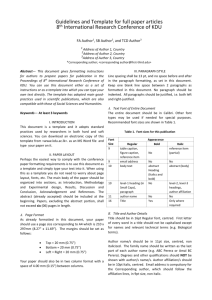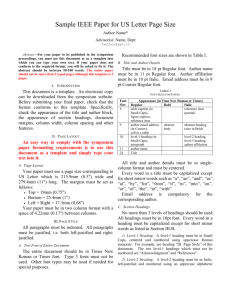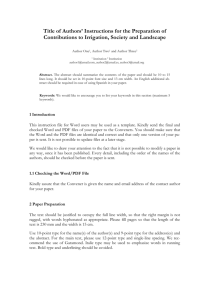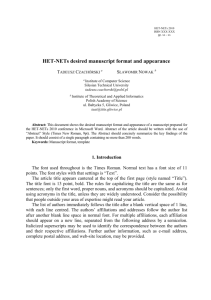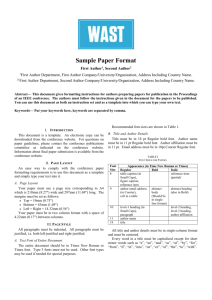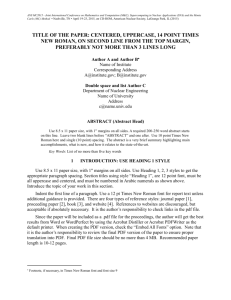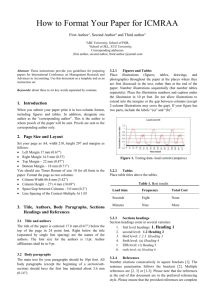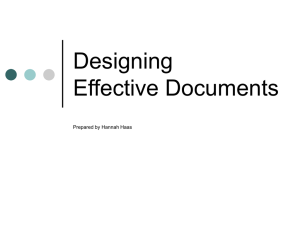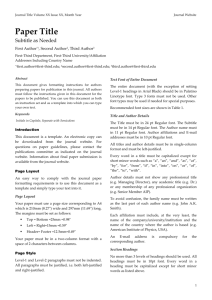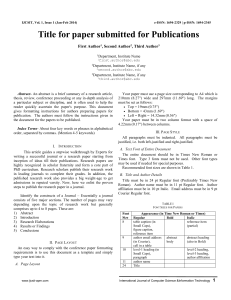SATNAC MS Word Template
advertisement
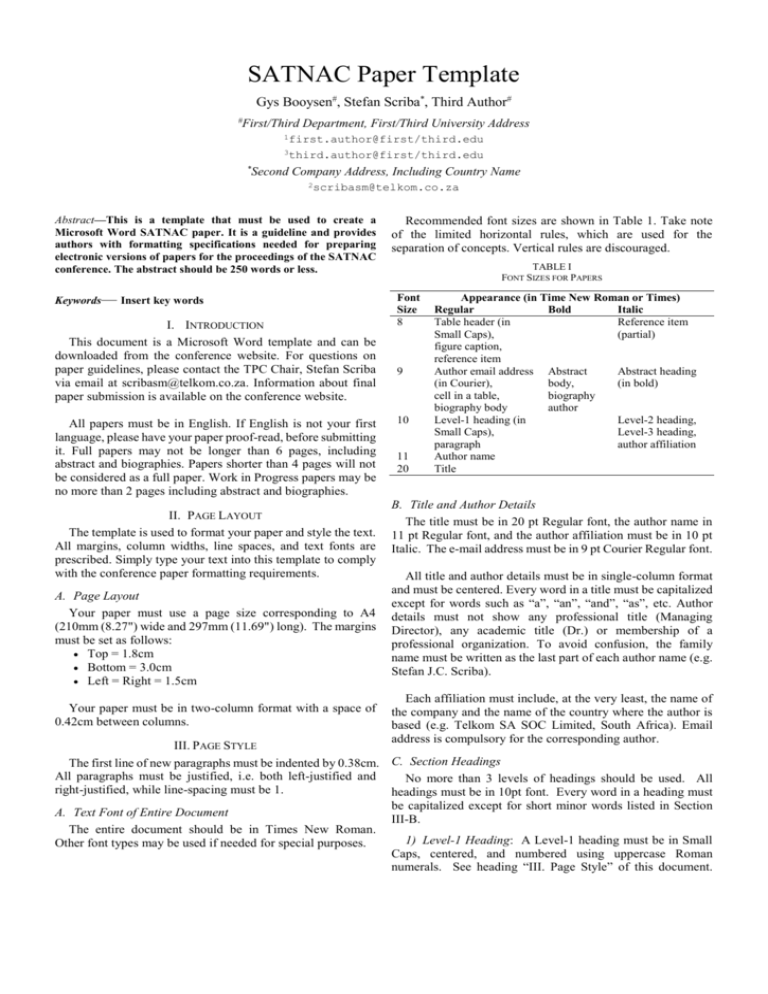
SATNAC Paper Template Gys Booysen#, Stefan Scriba*, Third Author# # First/Third Department, First/Third University Address 1first.author@first/third.edu 3third.author@first/third.edu * Second Company Address, Including Country Name 2scribasm@telkom.co.za Abstract—This is a template that must be used to create a Microsoft Word SATNAC paper. It is a guideline and provides authors with formatting specifications needed for preparing electronic versions of papers for the proceedings of the SATNAC conference. The abstract should be 250 words or less. Keywords— Insert key words I. INTRODUCTION This document is a Microsoft Word template and can be downloaded from the conference website. For questions on paper guidelines, please contact the TPC Chair, Stefan Scriba via email at scribasm@telkom.co.za. Information about final paper submission is available on the conference website. All papers must be in English. If English is not your first language, please have your paper proof-read, before submitting it. Full papers may not be longer than 6 pages, including abstract and biographies. Papers shorter than 4 pages will not be considered as a full paper. Work in Progress papers may be no more than 2 pages including abstract and biographies. II. PAGE LAYOUT The template is used to format your paper and style the text. All margins, column widths, line spaces, and text fonts are prescribed. Simply type your text into this template to comply with the conference paper formatting requirements. A. Page Layout Your paper must use a page size corresponding to A4 (210mm (8.27") wide and 297mm (11.69") long). The margins must be set as follows: Top = 1.8cm Bottom = 3.0cm Left = Right = 1.5cm Your paper must be in two-column format with a space of 0.42cm between columns. Recommended font sizes are shown in Table 1. Take note of the limited horizontal rules, which are used for the separation of concepts. Vertical rules are discouraged. TABLE I FONT SIZES FOR PAPERS Font Size 8 9 10 11 20 Appearance (in Time New Roman or Times) Regular Bold Italic Table header (in Reference item Small Caps), (partial) figure caption, reference item Author email address Abstract Abstract heading (in Courier), body, (in bold) cell in a table, biography biography body author Level-1 heading (in Level-2 heading, Small Caps), Level-3 heading, paragraph author affiliation Author name Title B. Title and Author Details The title must be in 20 pt Regular font, the author name in 11 pt Regular font, and the author affiliation must be in 10 pt Italic. The e-mail address must be in 9 pt Courier Regular font. All title and author details must be in single-column format and must be centered. Every word in a title must be capitalized except for words such as “a”, “an”, “and”, “as”, etc. Author details must not show any professional title (Managing Director), any academic title (Dr.) or membership of a professional organization. To avoid confusion, the family name must be written as the last part of each author name (e.g. Stefan J.C. Scriba). Each affiliation must include, at the very least, the name of the company and the name of the country where the author is based (e.g. Telkom SA SOC Limited, South Africa). Email address is compulsory for the corresponding author. III. PAGE STYLE The first line of new paragraphs must be indented by 0.38cm. C. Section Headings All paragraphs must be justified, i.e. both left-justified and No more than 3 levels of headings should be used. All right-justified, while line-spacing must be 1. headings must be in 10pt font. Every word in a heading must be capitalized except for short minor words listed in Section A. Text Font of Entire Document III-B. The entire document should be in Times New Roman. 1) Level-1 Heading: A Level-1 heading must be in Small Other font types may be used if needed for special purposes. Caps, centered, and numbered using uppercase Roman numerals. See heading “III. Page Style” of this document. “Acknowledgment” and “References” are two Level-1 headings which may not be numbered. 2) Level-2 Heading: A Level-2 heading must be in Italic, left-justified, and numbered using an uppercase alphabetic letter, followed by a period. See “C. Section Headings” above. 3) Level-3 Heading: A Level-3 heading must be indented, in Italic, and numbered with an Arabic numeral, followed by a right parenthesis. The heading must end with a colon. The body follows the level-3 heading in the same line. D. Figures and Tables Figures and tables must be centered within the column. Large figures and tables may span across both columns, but must be positioned either at the top or at the bottom of the page. Any text within diagrams must be clearly legible (size 6, minimum). Please use vector graphics, where possible. E. Figure Captions Figure captions must be in 8 pt Regular font and numbered using Arabic numerals. Captions of a single line must be centered, whereas multi-line captions must be justified. Captions with figure numbers must be placed below their associated figures. Captions must be numbered with the word “Figure”, followed by an Arabic number, a colon, and the caption title: “Figure 1: An example”. When referencing a figure, the abbreviation Fig. 1 is used. When referencing multiple Figures, use Figs. 1-4, or Figs. 1,3,4. Examples of reference items of different categories shown in the References section include: example of a book in [1] example of a book in a series in [2] example of a journal article in [3] example of a conference paper in [4] example of a patent in [5] example of a website in [6] example of a web page in [7] example of a manual in [8] example of a datasheet in [9] example of a master’s thesis in [10] example of a technical report in [11] example of a standard in [12] When referring to a reference item, use the reference number [2]. Do not use “Ref. [3]” or “Reference [3]”, except at the beginning of a sentence, e.g. “Reference [3] shows …”. Members of a reference list are each numbered with separate brackets (e.g. [2], [3], [4]–[6]). ACKNOWLEDGMENT The heading of the Acknowledgment and References sections may not be numbered. REFERENCES [1] [2] F. Table Headings Tables must be numbered using uppercase Roman numerals. Table headings must be centred and in 8 pt Regular font with Small Caps. Every word in a table heading must be capitalized, except for short minor words as listed in Section III-B. Headings must be placed above their associated tables, as shown in Table 1. G. Mathematical Expressions Microsoft Word struggles to display mathematical expressions. Especially, expression numbering is usually done manually. Mathematical expressions are centered within a column. For very large equations, the expression may span both columns, but must then be positioned at the top or bottom of a page. All mathematical expressions must be numbered within round brackets, in line with the expression and right-justified. Use (1) as the labelling convention to reference the following example expression: 𝑛 (𝑥 + 𝑎)𝑛 = ∑ (𝑛𝑘)𝑥 𝑘 𝑎𝑛−𝑘 (1) 𝑘=0 H. Page Numbers, Headers, and Footers Page numbers, headers, and footers may NOT be used. These will be inserted later, when the SATNAC Proceedings booklet is compiled. I. References All reference items must be in 8 pt font. Number the reference items consecutively in square brackets (e.g. [1]). [3] [4] [5] [6] [7] [8] [9] [10] [11] [12] S. M. Metev and V. P. Veiko, Laser Assisted Microtechnology, 2nd ed., R. M. Osgood, Jr., Ed. Berlin, Germany: Springer-Verlag, 1998. J. Breckling, Ed., The Analysis of Directional Time Series: Applications to Wind Speed and Direction, ser. Lecture Notes in Statistics. Berlin, Germany: Springer, 1989, vol. 61. S. Zhang, C. Zhu, J. K. O. Sin, and P. K. T. Mok, “A novel ultrathin elevated channel low-temperature poly-Si TFT,” IEEE Electron Device Lett., vol. 20, pp. 569–571, Nov. 1999. M. Wegmuller, J. P. von der Weid, P. Oberson, and N. Gisin, “High resolution fiber distributed measurements with coherent OFDR,” in, 2000, paper 11.3.4, p. 109. R. E. Sorace, V. S. Reinhardt, and S. A. Vaughn, “High-speed digitalto-RF converter,” U.S. Patent 5 668 842, Sept. 16, 1997. (2002) The IEEE website. [Online]. Available: http://www.ieee.org/ M. Shell. (2002) IEEEtran homepage on CTAN. [Online]. Available: http://www.ctan.org/texarchive/macros/latex/contrib/supported/IEEEtran/ FLEXChip Signal Processor (MC68175/D), Motorola, 1996. “PDCA12-70 data sheet,” Opto Speed SA, Mezzovico, Switzerland. A. Karnik, “Performance of TCP congestion control with rate feedback: TCP/ABR and rate adaptive TCP/IP,” M. Eng. thesis, Indian Institute of Science, Bangalore, India, Jan. 1999. J. Padhye, V. Firoiu, and D. Towsley, “A stochastic model of TCP Reno congestion avoidance and control,” Univ. of Massachusetts, Amherst, MA, CMPSCI Tech. Rep. 99-02, 1999. Wireless LAN Medium Access Control (MAC) and Physical Layer (PHY) Specification, IEEE Std. 802.11, 1997. Gys Booysen is the SATNAC Secretariat and member of the SATNAC Organising Committee. He runs Telkom’s CoE programme. The biography is written in Times New Roman, font size 9, with the author names in bold. Academic titles (Dr., Prof.) and photos of the authors are not included. Stefan M. Scriba received his PhD in 2010. He is TPC Chair of SATNAC and a Telkom Manager, running the SLA and Quality of Service development team within Telkom’s Technical Product Development section. Please contact Stefan for further questions.
